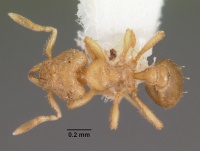Strumigenys gyges
| Strumigenys gyges | |
|---|---|

| |
| Scientific classification | |
| Kingdom: | Animalia |
| Phylum: | Arthropoda |
| Class: | Insecta |
| Order: | Hymenoptera |
| Family: | Formicidae |
| Subfamily: | Myrmicinae |
| Tribe: | Attini |
| Genus: | Strumigenys |
| Species: | S. gyges |
| Binomial name | |
| Strumigenys gyges (Bolton, 2000) | |
Nothing is known about the biology of Strumigenys gyges.
Identification
Bolton (2000) - The only member of the Strumigenys gyges-group. The 5-segmented antennae and unique mandibles render gyges immediately recognisable. In the regions currently under consideration only one species (Strumigenys nepalensis) has 4-segmented antennae, gyges has 5, and all the remainder have 6.
Keys including this Species
Distribution
Latitudinal Distribution Pattern
Latitudinal Range: 4.466670036° to 4.466670036°.
| North Temperate |
North Subtropical |
Tropical | South Subtropical |
South Temperate |
- Source: AntMaps
Distribution based on Regional Taxon Lists
Indo-Australian Region: Malaysia (type locality).
Distribution based on AntMaps
Distribution based on AntWeb specimens
Check data from AntWeb
Countries Occupied
| Number of countries occupied by this species based on AntWiki Regional Taxon Lists. In general, fewer countries occupied indicates a narrower range, while more countries indicates a more widespread species. |

|
Estimated Abundance
| Relative abundance based on number of AntMaps records per species (this species within the purple bar). Fewer records (to the left) indicates a less abundant/encountered species while more records (to the right) indicates more abundant/encountered species. |

|
Biology
Castes
Nomenclature
The following information is derived from Barry Bolton's Online Catalogue of the Ants of the World.
- gyges. Pyramica gyges Bolton, 2000: 424, figs. 261, 300 (w.q.) WEST MALAYSIA. Combination in Strumigenys: Baroni Urbani & De Andrade, 2007: 120
Unless otherwise noted the text for the remainder of this section is reported from the publication that includes the original description.
Description
Worker
Holotype. TL 1.8, HL 0.44, HW 0.42, CI 95, ML 0.15, MI 34, SL 0.25, SI 60, PW 0.27, AL 0.50. Antenna with 5 segments; funiculus with only a single small segment between the first and the apical club. Clypeus finely and weakly punctulate, distinctly less strongly sculptured than remainder of head, which is reticulate-punctate. Cephalic dorsum with minute curved ground-pilosity and with two pairs of erect hairs on the posterior third. The anterior pair of hairs just in front of highest point of vertex and the posterior, more widely separated pair, just behind highest point of vertex (see notes under paratypes). Leading edge of scape, distal of the long flattened hair near the broadest point, with a row of small spatulate hairs that are curved toward the apex of the scape. Interspersed with these are even finer simple, similarly curved hairs. Eye of a single ommatidium. Dorsal alitrunk and waist segments without erect hairs, but first gastral tergite with a stout pair basally and a transverse row of 4 apically. The apices of these hairs are broadened and may have a jagged or frayed appearence. Dorsal (outer) surfaces of middle and hind tibiae with minute, apically curved hairs only. Pronotum not marginate dorsolaterally, its dorsum superficially sculptured. Mesonotum in profile forming a separate shallow convexity; posteriorly the dorsum of the propodeum sloping steeply downward. Ventral spongiform strip of petiole complete but narrow, in profile its depth less than half that of the peduncle. Lateral lobe of petiole node small and narrow, hardly more than a continuation of the posterior collar. Ventral lobe of postpetiole very small, in profile its area less than half that of the exposed node. Petiole node in dorsal view with faint vestiges of sculpture, much broader than long; its posterior collar narrow and its lateral lobes scarcely visible. Postpetiole smooth and shining, distinctly broader than long. Basigastral costulae absent or at most with minute vestiges.
Paratypes. TL 1.7-1.8, HL 0.44-0.47, HW 0.42-0.46, CI 95-100, ML 0.15-0.16, MI 32-36, SL 0.25-0.27, SI 57-60, PW 0.25-0.28, AL 0.48-0.52 (12 measured). As holotype but eye with 1-4 ommatidia in total (in single series). In a few paratypes a short thick hair projects laterally from about the midlength of the occipital lobe. Sometimes the posterior pair of hairs on the vertex is flanked by two more hairs located near the occipital corners, making an arched row of 4. It may be that a row of 4 hairs here is the correct state and that the outer two are easily lost by abrasion, but in the material available two is by far the commonest count.
Type Material
Holotype worker, Malaysia: Cameron Highlands, Bukit Mentiga, 1600 m., 23.iii.1993, no. 16a (Lobl & Calame) (Musee d'Histoire Naturelle Genève).
Paratypes. 34 workers and 4 queens with same data as holotype (MHNg, The Natural History Museum, Museum of Comparative Zoology, Australian National Insect Collection, Los Angeles County Museum of Natural History).
- Paratype, 5 workers, Cameron Highlands, Bukit Mentiga [Bukit Mentigi], Malaysia, Löbl & Calame, ANIC32-001165, Australian National Insect Collection.
References
- Baroni Urbani, C. & De Andrade, M.L. 2007. The ant tribe Dacetini: limits and constituent genera, with descriptions of new species. Annali del Museo Civico di Storia Naturale “G. Doria” 99:1-191.
- Bolton, B. 2000. The ant tribe Dacetini. Memoirs of the American Entomological Institute. 65:1-1028. (page 424, figs. 261, 300 worker described)
References based on Global Ant Biodiversity Informatics
- Bolton B. 2000. The ant tribe Dacetini. Memoirs of the American Entomological Institute 65: 1-1028.

